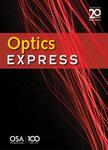版权所有:内蒙古大学图书馆 技术提供:维普资讯• 智图
内蒙古自治区呼和浩特市赛罕区大学西街235号 邮编: 010021

作者机构:MIT Dept Math Cambridge MA 02139 USA Harvard Univ Sch Engn & Appl Sci Cambridge MA 02138 USA MIT Dept Phys Cambridge MA 02139 USA
出 版 物:《OPTICS EXPRESS》 (Opt. Express)
年 卷 期:2011年第19卷第3期
页 面:2225-2241页
核心收录:
学科分类:070207[理学-光学] 07[理学] 08[工学] 0803[工学-光学工程] 0702[理学-物理学]
基 金:Army Research Office through the ISN [W911NF-07-D-0004] Defense Advanced Research Projects Agency (DARPA) [N66001-09-1-2070-DOD]
主 题:Computation methods Guided mode resonance Optical force Planar waveguides Resonant modes Waveguide modes
摘 要:We demonstrate that tunable attractive (bonding) and repulsive (anti-bonding) forces can arise in highly asymmetric structures coupled to external radiation, a consequence of the bonding/anti-bonding level repulsion of guided-wave resonances that was first predicted in symmetric systems. Our focus is a geometry consisting of a photonic-crystal (holey) membrane suspended above an unpatterned layered substrate, supporting planar waveguide modes that can couple via the periodic modulation of the holey membrane. Asymmetric geometries have a clear advantage in ease of fabrication and experimental characterization compared to symmetric double-membrane structures. We show that the asymmetry can also lead to unusual behavior in the force magnitudes of a bonding/antibonding pair as the membrane separation changes, including nonmonotonic dependences on the separation. We propose a computational method that obtains the entire force spectrum via a single time-domain simulation, by Fourier-transforming the response to a short pulse and thereby obtaining the frequency-dependent stress tensor. We point out that by operating with two, instead of a single frequency, these evanescent forces can be exploited to tune the spring constant of the membrane without changing its equilibrium separation. (C) 2011 Optical Society of America